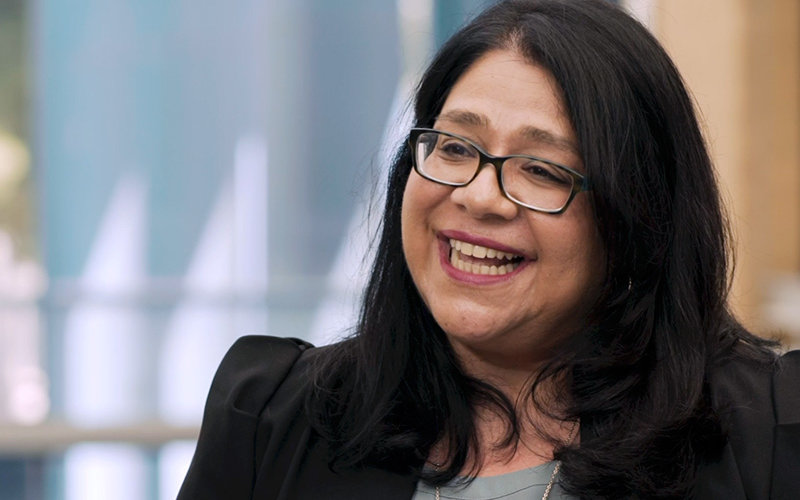
The times, they are a changin’ … and with it come new challenges to communities faced with urban sprawl, climate change, crises like hurricanes and tornadoes, health concerns and more. Are there solutions to these issues? Ways that communities can face the needs and changes of the future?
Mojgan Sami believes there is with environmentally sustainable planning and the will to think beyond growth and development.
“Environmentally sustainable planning is essentially the process of infrastructure development in the community,” explains Sami, assistant professor of public health at Cal State Fullerton. “Planners work at the intersection of economic growth, social justice and environmental sustainability.”
The scholar, who earned her doctorate at UC Irvine and has conducted research in the field in Orange County and globally, is passionate about the subject that has shaped her studies, professional presentations and extensive publications.
As Sami explains it, planning, tends to focus on on economic growth. But, it’s the political inclination of a city or region that shapes it beyond growth and considers environmental impact, sustainability and/or social justice.
“Of course, there are regulations and our systems have checks and balances — such as the environmental impact review — to ensure that no new development project harms the land or the community, but they are not always as effective as we need them to be,” she warns.
“Environmentally sustainable planning takes the most ecologically protective approach to planning new development,” she adds. ”Such processes may follow principles of biomimicry, i.e., modeled on biological entities and processes, such as the Bullitt Center in Seattle, or find ways to decrease the carbon footprint of a building by using renewable energy, or decrease the urban heat island effect by installing green/reflective roofs or design landscape infrastructure that takes into account water reclamation, renewable energy and restores native habitats.”
And such planning may be what helps communities address climate change.
“The World Health Organization calls climate change the greatest threat to human health in the 21st century,” Sami notes. “It affects the social and environmental determinants of health, such as our air, water, nutritional content in food, shelter.
“We know that climate change is shifting weather and climate patterns, which is impacting infectious disease control and prevention. For example, malaria is appearing in higher elevations and communities around the world and the individuals in those communities are experiencing extreme heat and weather events that their infrastructure is not equipped to sustain.
“If we do not invest in sustainable infrastructure today, we will pay for it in the future.”
“In fact, health experts call climate change a ‘threat multiplier’ because it is not just the immediate danger of a disaster event, but the subsequent indirect impacts on our health and well-being that continue to affect once the disaster is averted.”
An example is 2017’s Hurricane Maria in Puerto Rico, where electricity is still not completely restored on the island — and the Bahamas, currently suffering from post-hurricane Dorian consequences.
“Environmentally sustainable planning provides a framework to design, build and create structures that consider climate change in their design from the beginning – not as an add-on,” says the researcher. “So, in Southern California, we are anticipating more droughts and sea-level rise, which will impact vulnerable communities the most.”
She cautions that cost-benefit analysis of infrastructure design needs to include both long-term/ short-term consequences of planning and development decisions. “If we do not invest in sustainable infrastructure today, we will pay for it in the future.”
For example, “economists are warning against any investment in infrastructure that harms the natural environment, or public health and community cohesion,” Sami says. “Climate change will require us to make difficult decisions about building and rebuilding in communities devastated by annual floods, storms, wildfires and droughts.”
“These are not political issues, these are scientific realities that planners need to address to protect the health, welfare and safety of our communities and our planet,” Sami adds. “The United Nations calls on communities to plan for adaptation and mitigation for climate change. Adaptation is about designing and building with climate change impacts in mind; mitigation is about decreasing greenhouse gases so we do not exacerbate the climate crisis.
“When we design and build with these concepts in mind, we directly improve community and planetary health. Research shows that high amounts of emissions are correlated with increased hospital visits by children with asthma. So, if we just focus on increasing health care for children to receive asthma treatment without also addressing the underlying causes of their asthma, are we really addressing the cause of their asthma? Environmentally sustainable planning is essentially about health equity.”
This story is part of a climate change package: “Climate Change Crisis: Faculty and Student Researchers Seek Solutions.”
